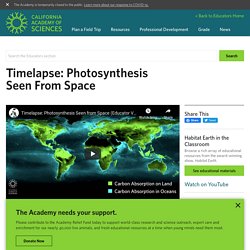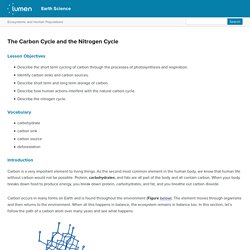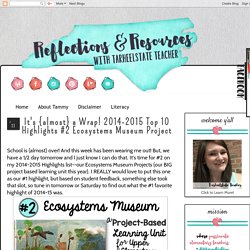

(1) Bill Nye The Science Guy Water Cycle. How do Trees Survive Winter? Virtual Field Trip Video: Africa. Video: Timelapse: Photosynthesis Seen From Space. "We will be looking at food webs this year, so all the information about photosynthesis and the food chain are great supplemental materials to our curriculum.

"-3rd-5th Grade Science Teacher from San Rafael, CA "I would use the Timelapse of Photosynthesis from Space as an assessment of students' understanding of photosynthesis inputs and outputs. " -Middle School Life Science Teacher from Pleasant Hill, CA "I showed the entire Habitat Earth film as a virtual field trip at the end of our cell energy unit. "I will be using the timelapse photosynthesis with our climate unit, because it is an excellent visualization tool. " "The short videos of photosynthesis from space and bird migrations overlaying photosynthesis, and the water transport videos will be great hook activities for my cell energetics lessons. "I suggested the photosynthesis from space video as a phenomenon to base a photosynthesis lesson on for NGSS implementation work I am doing with other science teachers.
" Discover Life. High school biology.
Notebook 2 Ecosystems -Resources. Notebook 3: Food Webs and Food Chains. Unit 3 Ecosystems Videos. Photosynthesis Challenge. Kat's AP Environmental Science Blog. PBS LEARNING MEDIA Ecology LESSONS. Prairie Investigation. Hype vs. Reality at the MIT Media Lab. Ecosystem Activities. PBL Ecosystems Project: claim evidence reasoning – The 5E Teacher. What is Turbidity? What is Turbidity?

The definition of Turbidity is the cloudiness or haziness of a fluid caused by suspended solids that are usually invisible to the naked eye. The measurement of Turbidity is an important test when trying to determine the quality of water. It is an aggregate optical property of the water and does not identify individual substances; it just says something is there. Water almost always contains suspended solids that consist of many different particles of varying sizes. Some of the particles are large enough and heavy enough to eventually settle to the bottom of a container if a sample is left standing (these are the settleable solids). The term Turbidity (also called haze) can also be applied to transparent solids like plastic and glass.
What Causes Turbidity? Organisms like phytoplankton can contribute to turbidity in open water. In drinking water the higher the level of turbidity, the higher the chance that those using it could develop gastrointestinal diseases. The Carbon Cycle and the Nitrogen Cycle. Lesson Objectives Describe the short term cycling of carbon through the processes of photosynthesis and respiration.Identify carbon sinks and carbon sources.Describe short term and long term storage of carbon.Describe how human actions interfere with the natural carbon cycle.Describe the nitrogen cycle.

Vocabulary carbohydratecarbon sinkcarbon sourcedeforestation Introduction Carbon is a very important element to living things. Courses Tutorials Videos. Encyclopedia of Life. Virtual Urchin - Specimen Compare. BBC One - Planet Earth II, Grasslands, In pictures... - A giant ant-eater uses powerful claws longer than a velociraptor's to tear open a termite mound. Eco-Column: 8 Steps. AdWords We use AdWords to deploy digital advertising on sites supported by AdWords. Ads are based on both AdWords data and behavioral data that we collect while you’re on our sites.
The data we collect may include pages you’ve visited, trials you’ve initiated, videos you’ve played, purchases you’ve made, and your IP address or device ID. This information may be combined with data that AdWords has collected from you. We use the data that we provide to AdWords to better customize your digital advertising experience and present you with more relevant ads. LiveRamp We use LiveRamp to deploy digital advertising on sites supported by LiveRamp.
Doubleclick We use Doubleclick to deploy digital advertising on sites supported by Doubleclick. RocketFuel We use RocketFuel to deploy digital advertising on sites supported by RocketFuel. Twitter.
Ecosystems 2 Animal Research. Populations and Ecosystems. 313 01. Oh, deer! 5 minutes (trimmed) Reflections and Resources from Tarheelstate Teacher: It's {almost} a Wrap! 2014-2015 Top 10 Highlights #2 Ecosystems Museum Project. School is {almost} over!

And this week has been wearing me out! But, we have a 1/2 day tomorrow and I just know I can do that. It's time for #2 on my 2014-2015 Highlights list--our Ecosystems Museum Projects {our BIG project based learning unit this year}. I REALLY would love to put this one as our #1 highlight, but based on student feedback, something else took that slot, so tune in tomorrow or Saturday to find out what the #1 favorite highlight of 2014-15 was. I wrote about our Ecosystems Museum projects in detail earlier this year on Life, Love, Literacy so I'm prepared to tell you all about what we did.
I dare say this project was really fun and meaningful AND allowed me to incorporate lots of Language Arts and technology goals into a science-based unit. To launch our project, we planned a field trip to a local Natural Sciences museum. Driving Question: Project-based learning is supposed to start with a driving question. You might ask how much time this took.